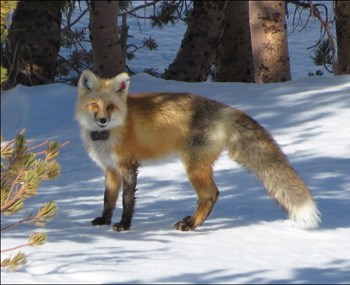
NPS
A priceless photo of a small red fox padding effortlessly atop a crest of snow in the far northern wilderness of Yosemite National Park was proof that a creature long thought extirpated in the park was indeed alive. The detections by motion sensor cameras in December 2014 and January 2015 brought to life the Sierra Nevada red fox: A most rare, elusive, and hardy creature, native to the Sierra Nevada of California, with genetic roots reaching back to the last Ice Age.
Last seen within Yosemite National Park boundaries in 1916, Yosemite wildlife biologists were on the lookout for the Sierra Nevada red fox after a confirmed sighting by a motion sensor camera was made at nearby Sonora Pass in 2010. The Sonora Pass detection included a bait bag with tooth punctures, which allowed University of California Davis genetics researchers to conduct a DNA analysis of saliva found on the bag. When compared to DNA extracted from Sierra Nevada red fox museum specimens collected prior to 1926, a most exciting discovery was made: the bite marks on the bait bag had the same genetic signature as the museum specimens. The scientific findings confirmed the presence of the Sierra Nevada red fox in the Sonora Pass area, and created a most hopeful expectation that nearby Yosemite National Park was also the fox’s home. Historically the Sierra Nevada red fox roamed the high elevations of California’s Sierra Nevada and Southern Cascade Mountains for thousands of years. Prior to the 2010 Sonora Pass discovery, only one known remnant population of approximately 20 individuals remained in the historic range near Mt. Lassen. Prized by trappers for their soft, dense fur, sightings of the Sierra Nevada red fox began to greatly diminish by 1940. California prohibited trapping in 1974, and listed Sierra Nevada red fox as a threatened species in 1980. The United States Fish and Wildlife Service designated the Sonora Pass/Yosemite animals as proposed endangered species under the Endangered Species Act. 
The photos of the Yosemite Sierra Nevada red fox depict an obviously healthy animal with a jaunty step and a foxy, alert expression. The wonder of the photo lies with the elusiveness of the creature who without the camera detections may have remained hidden for many more years. What is certain is there are very few Sierra Nevada red foxes and this fact gives urgency to Yosemite National Park’s efforts to seek vital information about the animals in order to gain the information needed to eventually increase their population. Building on the success of the Yosemite Conservancy funded project that yielded the first photos, biologists deployed additional cameras along with hair snares (for DNA analysis) to determine the number of Sierra Nevada red foxes and their locations. The increased camera surveys, also funded by Yosemite Conservancy, have the added advantage of learning what other animals are overlapping with the Sierra Nevada red fox, and whether those creatures represent competitors or prey to the fox. Yosemite’s wildlife biologists have teamed up with other agencies, academic institutions, and private organizations to help continue the Sierra Nevada red fox’s important ecological legacy as a true California native and resident of Yosemite National Park. 
Chris Stermer |
Last updated: January 27, 2020
